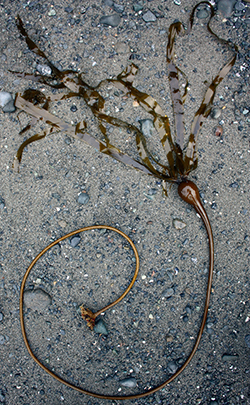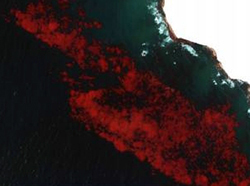

Beneath the waters off the California coast are vast forests that are home to an astounding variety of animals. Their sunlit canopies can soar 150 feet from the ocean’s floor. But instead of trees, these forests are made of kelp.
Worldwide, kelp is used in a host of everyday products like toothpaste, pudding, ice cream and even pharmaceuticals. Although kelp is valuable to humans, it is critical to sustaining life for many ocean-dwelling wildlife species ranging from microscopic plankton to sea otters, pelagic birds and predatory fishes. When a kelp forest is depleted, the entire underwater ecosystem can be thrown out of balance. This is why CDFW scientists are tracking and studying the amount of kelp growing in coastal waters.
In 1989, CDFW marine biologists began using aerial surveys to monitor the size of the kelp forests off of California’s coast. A second survey was conducted a decade later, and since 2002, CDFW has made an effort to conduct these surveys annually (although budget issues sometimes require skipping a year).
The surveys are conducted along the entire coastline and offshore of the Channel Islands. CDFW conducted the earliest surveys on its own, but now contracts out for this work. The contractor uses an aircraft with a specialized camera system that picks up the infrared image of the kelp. Those images become Geographic Information System (GIS) shapefiles that capture a snapshot of what the kelp canopy looks like on a given day. The images enable the viewer to see and compare the spatial area of a specific kelp forest over time.
A graph depicting CDFW’s historic aerial kelp survey data is located on the Kelp and Other Marine Algae webpage.
CDFW’s most recent (2016) kelp survey includes the following findings:
- The south coast mainland and the Channel Islands both experienced a reduction in kelp when compared to 2015 levels. The south coast mainland had almost half the canopy level surveyed the previous year.
- Along the central coast, kelp canopy levels were almost double that seen the previous year.
- North central canopy levels, while still low, were just over five times the 2015 survey levels.
- The north coast canopy levels were just over twice the 2015 measured canopy levels – but are still below the normal range for this area.
Rebecca Flores Miller, a marine environmental scientist with CDFW’s Marine Region office in Monterey, was the coordinator for the 2016 kelp survey.
“Kelp does fluctuate normally, anyway … there is a seasonality with it,” she explains. “However, during El Nino and warm water conditions as we’ve had in the recent past, the canopy doesn’t grow as well.”
Coastal development can also negatively affect the kelp canopy, as it sometimes leads to pollution, increased turbidity (which reduces the light needed for photosynthesis) and siltation (which can hinder growth or bury young kelp). An increase in urchin populations can also have a dramatic impact on kelp, and recently, a wasting disease decreased the numbers of sea stars (a predator of urchins) statewide.
“All of these things are connected within the ecosystem,” Flores Miller says.
Kelp survey data is available to anyone who is interested – members of the general public, other governmental agencies, universities and researchers.
The dataset has many uses, both within and outside of CDFW. It is used during the review process for commercial kelp bed lease requests. It has been a critical piece of the Marine Protected Area planning process. It has been used to help predict the abundance of many kelp forest-dependent species valued by humans, such as abalone. And it has helped scientists understand issues such as the recent abalone die-off in northern California.
CDFW Photos: giant kelp and bull kelp (by Rebecca Flores Miller), and image of kelp forest near Cambria taken during the 2016 aerial kelp survey.